
- Show results for
- Share
How to Use Multimeters
Resource Description

Electricity, as a matter of fact, performs a really significant role. Still, the voltage and current by which electricity is measured cannot be seen directly. How can such things be observed with a naked eye then? Voltage, current, and resistance can all become observable if a multimeter is used properly.
A multimeter is a device used to measure voltage, resistance, and current in electronics & electrical equipment. It is also used to test continuity between two points to verify if there are any breaks in the circuit or line.
Popular Products
Testing Voltage
Multimeters measure AC and DC voltages. Car batteries supply DC voltage, while wall outlets in your home supply AC voltage.
While digital multimeters give you measurements on a digital display, analog multimeters use a needle or a pointer on calibrated scales. To read its measurements you watch the movement of the needle and note the value in points on the scale. Some ranges won’t have their scales, so you may have to read a scale for another range, and then multiply or divide the reading.
How to test for voltage?
.jpg)
1. Select either AC or DC volts on your meter. If you are testing during a car stereo or car security installation, you’ll be testing for DC voltage. Set the meter to the appropriate range for the voltage you expect to find (unless your meter has auto-range). In a car, that would be 12 to 14 volts DC. In your home, you are to find around 120 volts AC. When measuring an unknown voltage, select the highest range and work down.
2. Touch the negative probe to a known ground (the chassis of the car) and touch the positive lead to the wire you’re testing. For accurate readings, make sure your ground point is bare metal (no paint, rust, etc.).
3. View the reading on the display.
When to test voltage?
Example 1: Test voltage when you need to find a specific wire in your car. For instance, if you need to locate the starter wire to hook up the starter disable function of a security system, test like this:
Touch the black probe to chassis ground, then use the red probe to check the wires coming off the ignition switch as you crank the starter. The wire that shows 12-14 volts when the key is in the “start" position and shows no voltage in any other position is the wire to be relay-interrupted.
Example 2: If there is no constant power wire on your factory radio wiring harness, you’ll need to find a source of constant 12-volt power and connect the memory wire on your new receiver to it. (This provides power for the clock and tuner memory in your new receiver.) You can find a power source at the fuse box or on the wire leading to your cigarette lighter in most vehicles. Leaving the ignition in the “off” position, touch the black probe to the ground. Then touch the red probe to the wire or fuse you suspect has constant power. If your meter shows 12-14 volts, disconnect the negative battery terminal, then splice the memory wire from your receiver to that wire or tap onto that fuse.
Testing/Measuring Current
Current (amps) is the flow of electrical charge through a component or conductor. Current is measured in amps or amperes.
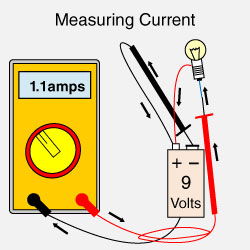
How to measure current?
1. Disconnect power source before testing.
2. Disconnect the completed circuit at the end of it.
3. Place the multimeter in series with the circuit.
4. Reconnect power source and turn ON.
5. Select the highest current setting and work your way down.
Why Test/Measure Current?
If there is not enough current, your circuit may not be able to do the work it was designed to do. Logic circuits may not function reliably, displays may be dim, and motors may stall.
On the other hand, if there is too much current, things will heat up, and components may be damaged. In extreme cases, there may even be smoke or flames.
Reasons for measuring current in a circuit include:
1. Determining circuit power requirements
2. Verifying correct circuit operation
3. Testing power supply performance
4. Verify that batteries are charging or discharging at a safe rate
5. Estimating battery life or recharge time
6. Diagnosing circuit problems
Testing For Continuity
If a circuit has a path through which electricity can flow, it is said to have continuity. A circuit with continuity is termed “closed.”
If the current cannot flow, because of extremely high resistance or a break in the circuit, the circuit is said to be “open" or to have no continuity. Testing for continuity lets you know if a circuit is open or closed.
How to test for continuity?
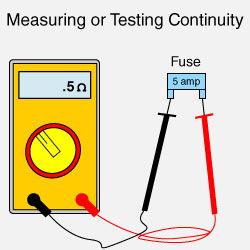
1. Turn off power to the circuit. If a voltage source is connected to the circuit during this test, you will damage the meter.
2. Select “resistance" on your multimeter (on an AMM, choose the lowest setting). If using an AMM, you must first “zero” the meter by touching the test probes together and turning the thumbwheel until the needle sits at zero.
3. Touch the probe tips across the component or portion of the circuit for which you want to determine continuity.
4. Read the meter. If the reading is low, it means you have continuity (the circuit is closed). If the reading is “infinity", it means there is no continuity (the circuit is open).
Why test for continuity?
Testing for continuity can help you identify good or blown fuses, as well as open or shorted wires or conductors, operational switches, and circuit paths. If a fuse is blown, there will be no continuity across the test points. If a switch is not functioning properly, there will be no continuity regardless of switch position.
A useful continuity test would be to verify that there is a good connection between wires. Let’s say you’ve just crimped two wires together and want to find out if your connection is good. To test this, you would touch one probe from your meter to one side of the connection, and then the other probe to the other side of the connection. If there is good continuity, you should get a low resistance measurement (typically 0-1 ohm).
Testing Resistance
What is resistance?
Resistance is measured in ohms and tells us how much a circuit resists the flow of electric current. Resistance values can vary greatly, from a few milliohms for contact resistance to billions of ohms for insulators.
How to measure resistance?1. Turn off power to the circuit. A resistance test must be performed with the circuit power off. Otherwise, it may result in damage to the meter or circuit. 2. Select “ohms" on your multimeter. If using an AMM, you must first ‘‘zero’' the meter by touching the test probes together and turning the thumbwheel until the needle sits at zero. 3. Touch the probe tips across the component or portion of the circuit you want to measure for resistance. For an accurate reading, make sure to disconnect the measured component from all other components. When measuring resistance, make sure that you do not touch the metal test probes with your fingers. The resistance in your body will confuse the meter and give you a false reading. 4. Read the meter. Make sure you read the unit of measurement properly on the display of your digital multimeter (DMM). If using an AMM, make sure you're reading the proper scale based on your settings. Why measure resistance?Measuring resistance allows you to determine the resistance of a load, the resistance of specific conductors, the value of a resistor, or the operation of a variable resistor. Example 1: A case in which a DIYer must test for resistance would be during the installation of a remote starter kit in a GM vehicle featuring the Vehicle Anti-Theft Security (V.A.T.S.) ignition key. To make the remote start feature work, you must install a resistor that matches the value of the resistor pellet on the ignition key. Use your meter to determine the value of that pellet by touching the probes to either side of the pellet. Then you can select the proper resistor and proceed with the installation. Example 2: Testing resistance is useful when you want to determine if a speaker is blown. Simply touch the probes to the speaker terminals. An infinite reading indicates that the voice coil has melted or opened. A zero reading means the resistance is so small that a short circuit must be present. A positive reading means the speaker is fine. |
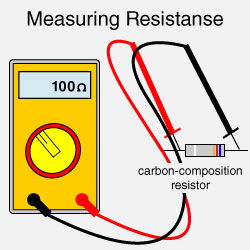 |
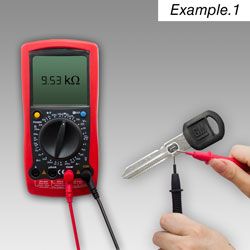
|
|
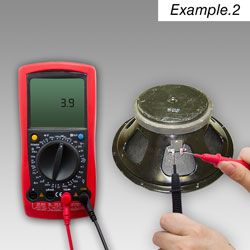 |

Sponsored ⓘ








